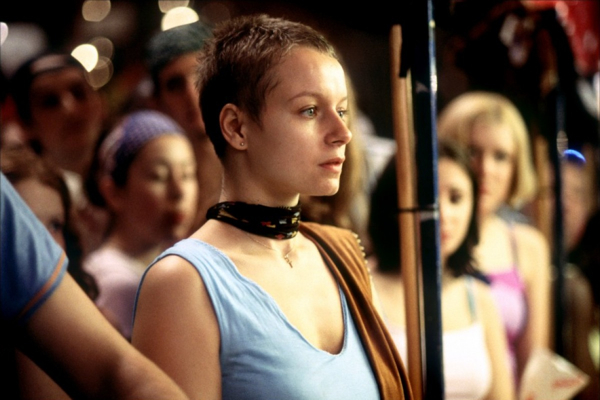Movie review by Greg Carlson
Along with his daughters Naomi and Kirsten, filmmaker Jim Sheridan wrote the semi-autobiographical heart-string tugger “In America,” an occasionally worthwhile family portrait burdened by odd anachronisms and too-obvious plays for audience sympathy. “In America” follows the fortunes and misfortunes of the Sullivans, a desperate Irish clan composed of father Johnny (Pady Considine), mother Sarah (Samantha Morton), and daughters Christy and Ariel (engrossingly played by real life sisters Sarah and Emma Bolger). Missing from the portrait is little brother Frankie, who died from the complications of a brain tumor that resulted after a spill down some stairs back in Ireland.
The Sullivans arrive in the New York City of celluloid dreams: they marvel at the neon carnival of Times Square, they take up residence in a drug-infested tenement, and they make fast friends with a multicultural rainbow of fellow immigrants who, like them, came to the Big Apple filled with hopes for a better life. In some ways, Sheridan strains to depict the city as a sweltering utopia, where neighbors throw parties for each other and even knife-wielding dope fiends apologize for their attempted assaults. Despite its sweaty look, excellently conveyed through the lens of cinematographer Declan Quinn, “In America” dons its thematic rose-colored glasses too often to earn any credibility for authenticity.
Of course, the grim memory of Frankie’s death has followed the group to NYC, and Christy, who constantly documents her world with the family camcorder, explains how she believes Frankie can grant three wishes from the great beyond. Sheridan takes plenty of time to demonstrate how the loss of their son has nearly destroyed Johnny and Sarah, but he tends to overstate the case – no wonder, then, that even Christy understands that her dad is going to have to find a way to move on if things are ever to return to some semblance of a happy life. The answer appears in the chiseled form of Mateo (Djimon Hounsou), a dying painter who rages against his own looming end.
As Mateo, Hounsou turns in a strong performance, probably one of the best of his career. The downside, however, is that Mateo is a character caught in a cinematic double-bind. Not only is he saddled with the “scary Black man who turns out to be a gentle soul” cliché, he joins the long list of ridiculously attractive actors who only seem to become more radiant as the grim reaper closes in. As expected, Sheridan pins the inevitable Sullivan family epiphany on the strong shoulders of Mateo, and the third act features a heavy-handed birth/death “circle of life” scene that feels like it belongs in the short story collection of a high school student.
“In America” is not without its charms. Morton is a fantastic performer, and instinctively finds ways to make even underwritten characters sparkle with intensity. The Bolger sisters are adorable; it’s a shame more of the story wasn’t told from their childhood perspective. The movie seems to spend a great deal of its running time, however, creating impressionistic sketches depicting the emotional adjustments made by the Sullivans to their new life. These scenes can be of interest, and are sometimes vivid, but they never really seem to add up to much.
